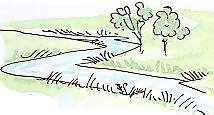 Hundreds
of creeks, streams, and rivers form the network which drains the
Puget Sound basin. All urban streams, and many rural ones, receive
runoff from lawns, fields, highways or parking lots. Sediments
from eroding streambanks and changes in land use can smother aquatic
life, clog fish gills, and cut off needed light to underwater
plants. How we manage the land around the streams and creeks in
our neighborhood helps determine the quality and quantity of water
flowing in the Sound.
Hundreds
of creeks, streams, and rivers form the network which drains the
Puget Sound basin. All urban streams, and many rural ones, receive
runoff from lawns, fields, highways or parking lots. Sediments
from eroding streambanks and changes in land use can smother aquatic
life, clog fish gills, and cut off needed light to underwater
plants. How we manage the land around the streams and creeks in
our neighborhood helps determine the quality and quantity of water
flowing in the Sound.
Streamside
areas are important to life in and around the stream. Trees and
low bushes shade the stream and help maintain water temperatures
that are suitable for fish while protecting streambanks from erosion.
Streams are dynamic systems. Erosion and siltation are natural
processes which can’t be totally eliminated, nor should they be,
but large scale removal of natural ground covers does impose an
unnecessarily heavy risk of excessive erosion and siltation.
Tiny ditches
belong to water networks that provide critical spawning and rearing
grounds for salmon, trout, and other aquatic life. They also provide
a constant supply of water to larger downstream livers, lakes
and the Puget Sound.
We can all
play a role in minimizing streambank erosion by taking a few simple
steps to improve stream quality. The most important control measure
is to make sure your stream is surrounded by plenty of trees.
As much as possible, leave stream banks and channels in their
natural, unaltered condition. Trees and shrubs are important to
both the stability of the streambank and to the health of the
stream itself. Trees should not be cleared away, their roots are
nature’s best purifying system, removing nutrients and excessive
sediments harmful to stream and Sound ecology.
Before you
plant trees on the banks of your neighborhood creek, call the
Department of Fisheries habitat office at (206) 753- 6550 for
information. Any work done within the ordinary high-water line
requires a hydraulic permit from the Department of Fisheries and/or
the Department of Wildlife (206) 753-3318.
 When
clearing land near a stream, leave a vegetation buffer strip along
the stream. The width of the strip depends on the slope of the
land and the existing vegetation. Your local soil conservation
district can provide you with assistance on your site.
When
clearing land near a stream, leave a vegetation buffer strip along
the stream. The width of the strip depends on the slope of the
land and the existing vegetation. Your local soil conservation
district can provide you with assistance on your site.
 Watering
and feeding areas for farm animals and horses should be kept away
from streams. Because trampling by livestock increases the potential
for streambank erosion, fencing or hedges should be used to restrict
livestock movement. Fencing and hedges can also be used to restrict
vehicle or foot traffic.
Watering
and feeding areas for farm animals and horses should be kept away
from streams. Because trampling by livestock increases the potential
for streambank erosion, fencing or hedges should be used to restrict
livestock movement. Fencing and hedges can also be used to restrict
vehicle or foot traffic.
Remove trash,
litter, and obstructions from your streambed. On the other hand,
leaning trees, large snags, and other obstructions on the streambank
may help stabilize the bank and benefit fish habitat. As with
tree planting within the high-water mark, a Hydraulic Project
Approval permit must be obtained before removing obstructions.
In cases
where streambank erosion is severe, vegetation alone will not
be adequate and structural measures may be required. Streambank
restoration requires the assistance of a trained professional.
Contact your local soil conservation district office for guidance
before attempting any structural work to protect your streambank.
In your planning, recognize that streams can be expected to naturally
shift their banks, sometimes gradually, sometimes abruptly.




